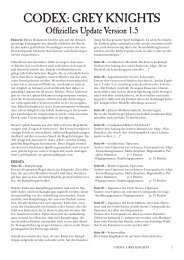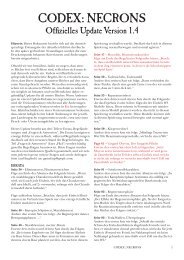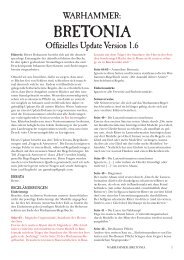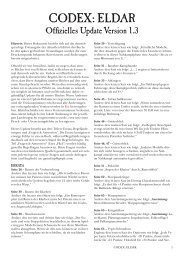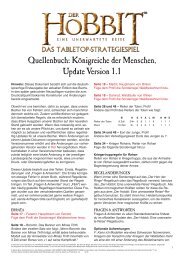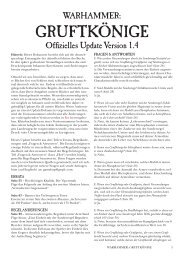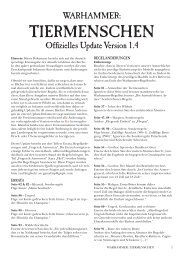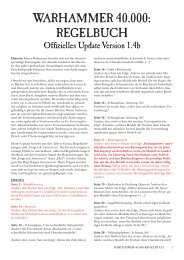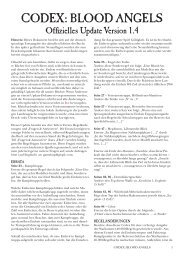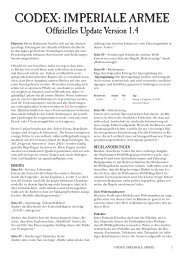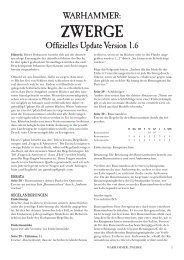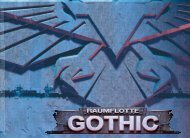Necromunda rulebook - Games Workshop
Necromunda rulebook - Games Workshop
Necromunda rulebook - Games Workshop
Create successful ePaper yourself
Turn your PDF publications into a flip-book with our unique Google optimized e-Paper software.
Note that a follow-up doesn’t affect a model’s ability<br />
to move in its following movement phase. The<br />
follow-up is an extra bonus move which reflects the<br />
intense activity of close quarter fighting.<br />
FIGHTERS DOWN<br />
Fighters who are wounded and go down are<br />
completely at the mercy of their enemy. In a one-onone<br />
combat any model that goes down is<br />
automatically out of action. His enemy finishes him<br />
off with a quick blow and the model is removed.<br />
In multiple combats a fighter who goes down has<br />
more chance of survival. Where all models on one<br />
side go down they are automatically out of combat.<br />
Where two or more models are fighting on the same<br />
side, some can go down and crawl away at 2" in their<br />
movement phase so long as at least one continues to<br />
fight.<br />
PINNED FIGHTERS AND<br />
HAND-TO-HAND COMBAT<br />
Fighters cannot be pinned when fighting hand-tohand<br />
combat. A fighter who is hit whilst engaged in<br />
hand-to-hand combat, even if hit by shooting in the<br />
shooting phase, is not pinned.<br />
If a fighter is already pinned when he is charged then<br />
the pin is discounted as soon as he is engaged.<br />
KEEPING YOUR NERVE<br />
This section of the rules is concerned with how your<br />
fighters react under fire: whether they bravely<br />
continue to fight while shells explode around them or<br />
whether they turn tail and run for cover. Regardless of<br />
your own feelings or those of the gang’s leader, even<br />
the most hardened gang fighter can be driven off or<br />
forced to take cover as the action hots up.<br />
LEADERSHIP TESTS<br />
A fighter may be called upon to take a test to see if his<br />
nerve holds. This test is taken using the model’s<br />
Leadership characteristic (Ld) and is therefore called a<br />
Leadership test. To take the test roll two dice (2D6)<br />
and add the scores together.<br />
If the result is more than your model’s Ld then the test<br />
is failed. The fighter’s nerve is broken and he runs to<br />
cover as described below.<br />
If the result is equal to or less than your model’s Ld<br />
then the test is passed, and the fighter keeps his nerve.<br />
In this case there is no further effect and the model<br />
continues to fight as normal.<br />
WHEN TO TEST<br />
If a model goes ‘down’ or ‘out of action’ then each<br />
friend within 2" must take an immediate Leadership<br />
test.<br />
LEADERSHIP<br />
25<br />
BROKEN FIGHTERS<br />
NECROMUNDA<br />
MOVING FROM COMBAT<br />
Once models are engaged in hand-to-hand fighting they<br />
cannot move away in their movement phase. They must<br />
stand and fight until they are taken out of action, until<br />
they take out their enemies, or until one or the other<br />
breaks and runs as described later.<br />
The only exception to the above is in a multiple<br />
combat, where fighters who are down may crawl away<br />
so long as friends continue to fight.<br />
BREAKING FROM COMBAT<br />
A fighter who loses his nerve whilst fighting hand-tohand<br />
combat will break off and make a run for it as<br />
described in the Leadership section.<br />
When a fighter breaks off from a fight he simply turns<br />
his back and runs off. His opponent automatically hits<br />
the fighter as he breaks, inflicting 1 hit which is worked<br />
out immediately.<br />
If a model fails a Leadership test then the fighter’s<br />
nerve has broken. For this reason we refer to such<br />
fighters as broken and you can indicate this by<br />
placing a Broken counter by the model if you wish.<br />
The broken fighter is momentarily panicked or<br />
shaken and will attempt to run for cover. He might<br />
recover sufficiently to return to the fray once he has<br />
steeled himself to fight on.<br />
Run to Cover<br />
As soon as a fighter is broken he turns tail and runs<br />
for cover. This movement takes place outside the<br />
normal turn sequence and is worked out<br />
immediately. The fighter makes a dash of up to 2D6"<br />
away from his enemy and towards cover. Roll the dice<br />
and determine how far the model runs.<br />
If he can reach a position of cover within this distance<br />
where he cannot be seen then he stops there.<br />
If he is unable to reach cover where he cannot be<br />
seen the fighter runs the full distance rolled. In<br />
subsequent movement phases he continues to move<br />
2D6" away from the enemy until he reaches such a<br />
position. If he can get out of sight by staying where<br />
he is and hiding then he will do so (see the<br />
Movement section).



